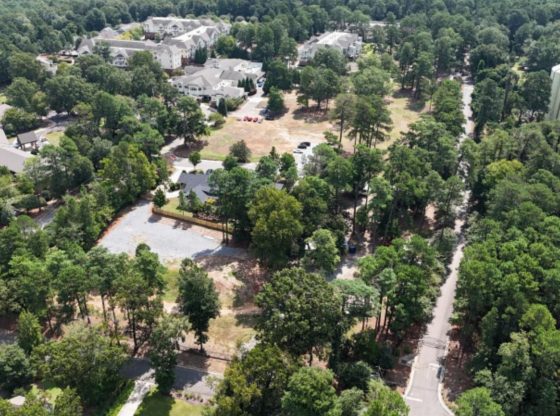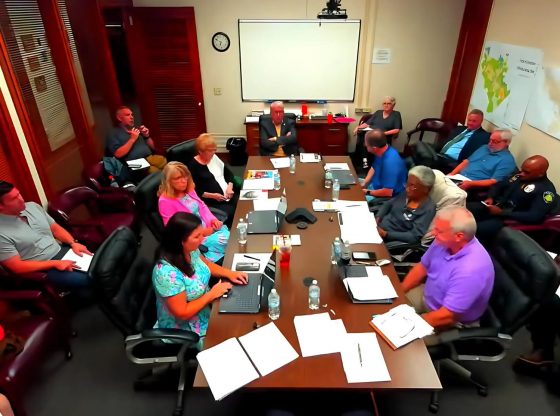In a joint effort to address the growth, development, and pressing needs of the county’s schools, the Moore County Board of Commissioners and Moore County Board of Education came together in a meeting held on Feb. 9.
“The reason we call this meeting is that it’s vital for us to know where each other’s priorities are going; it seems like quite a list since it continues to grow as Moore County grows,” said Chair Commissioner Nick Picerno. “We make sure Moore County has good law enforcement, good schools, and that we do not waste taxpayers’ money.”
The meeting centered largely around a presentation titled “Moore County Schools Capital Needs and Master Facility Projects Prioritized List,” which discussed upcoming projects crucial for the growth and development of the educational system in the county.
The slideshow was presented by Superintendent Dr. Tim Locklair and Assistant Superintendent for Operations Jenny Purvis. Light was shed on challenges currently faced by the school system, including traffic management and securing resources for safety measures and school resource officers (SROs). Many of the projects discussed in the presentation remained from the previous Master Facility List in 2015.
High Schools: Remodel or Build New?
The largest project tackled in the presentation was whether the county should focus on expanding preexisting Union Pines and Pinecrest, or if a new high school should be constructed and Union Pines and Pinecrest should simply be “modernized” instead.
Initial plans drafted by SFL&A architects in 2015 focused on modernizing Pinecrest and Union Pines to match current capacity levels but did not address anticipated future growth. To adequately address capacity concerns using existing campuses, revisions to the plans would be necessary to accommodate projected growth in the county. Alternatively, constructing a new high school capable of accommodating around 1400 students could alleviate capacity issues, allowing for renovations rather than extensive expansions at Union Pines and Pinecrest.
The presentation showed estimated costs ranging from $290 to $320 million. Commissioners requested a budget breakdown and determined that an entirely new school would cost around $160 million.
“It looks like building two new schools is almost the same price as just renovating the old ones,” said Commissioner Jim Von Canon. “We’re going to need an additional high school; it doesn’t seem like bang for our buck to put all of the money into renovations when we need a new high school anyway.”
Speakers from the board of education agreed that the current high schools need renovations in addition to a new school being built. School board member David Hensley estimated that 40% of costs could be cut if the buildings were designed with what is necessary and reasonable in mind instead of state-of-the-art grandeur.
Both commissioners and the majority of the school board agreed that taxpayers’ money should not be wasted on extravagant architecture and unnecessary modernization for the sake of being grandiose. Von Canon noted that in terms of budget, recent projects have “failed us miserably.”
School board member Pauline Bruno agreed. “We’re here to talk to the public, to talk to the commissioners, to make sure what happened before will not happen again,” she said, “that we don’t spend the taxpayers’ money on a great big elaborate school that we don’t need.”
The majority of the board of education agreed and wanted new architects and consultants brought in for future undertakings, not just for the high schools.
“We need to build this school for our kids. We need to make sure that it is the best school possible—maybe not with atrium ceilings. I get that,” conceded School Board Chair Robert Levy, “but [we need to] make sure it’s there for our special needs kids, our kids who have learning disabilities, to have the correct audio-visual equipment built into the school.”
Carthage Elementary
Similarly, the future of Carthage Elementary was heavily debated throughout the meeting.
The initially proposed plan was to build a new “replacement” elementary school and then demolish the old one once the replacement was complete. Those in favor of rebuilding Carthage Elementary and then demolishing the old structure emphasized the need for significant renovations due to the aging infrastructure of the current building, ongoing issues with traffic, and security. The estimated budget is $40 million.
However, speakers from the board of education did note that they were open to hearing ideas about renovating the building instead of constructing an entirely new one, even if it was a lengthy undertaking.
“I’m following you on building a new school but not tearing the old school down,” said Von Canon. “If it’s just a replacement, I don’t think we should raze that school. We could build somewhere else.”
Hensley concurred with Von Canon’s statement. “As you can see, they already want to tear down the school without talking to a single member of the public,” Hensley noted. “No public input, yet they’re [looking to] tear it down. We should discuss it with Carthage: determine where we could build a new school, build the new school, move the students, then renovate Carthage Elementary and keep it usable.”
Levy argued that there are too many ongoing issues with traffic and that the school is too open, creating a safety concern.
“Traffic is backed up all over the county; it’s been brought up for over ten years,” rebutted Von Canon. “We can come up with solutions. We’re wasting space—we can do better.” He suggested that space could be better utilized to create a more effective traffic flow if the school was undergoing major remodeling.
Proponents for rebuilding the school entirely cited concerns about outdated facilities and physical features such as roofing, plumbing, electrical, and other essential systems, which would require substantial investment to bring up to modern standards. They suggested that tearing down the old school and constructing a new one on the same site would ensure a fresh start and address the longstanding issues comprehensively.
Safety Concerns and SROs
Throughout the meeting, several points were raised by both sides regarding the role of SROs and general safety in Moore County Schools.
Von Canon, in particular, highlighted safety as a top concern, referring to children as “Moore County’s most valuable asset.” He noted that “it was previously agreed by the board of commissioners to fully fund the previous request for SROs.”
Levy directly addressed the current issues with school security and their causes. He—supported by several other board of education members—explained that many Moore County schools are too “open,” allowing for too many possible points of attack.
Commissioners Kurt Cook and Von Canon did not believe schools needed to be rebuilt solely because of security concerns. Cook suggested exploring other avenues for furthering safety measures, including bringing in new consultants and contractors with different experiences, approaches, and backgrounds. Ten-foot fences were also proposed as an alternative cheaper than tearing down and rebuilding entire schools.
Von Canon additionally disagreed with the “one entrance” approach, believing that schools having only one entrance make it easily blocked and compromised, rendering students defenseless within.
While on the subject of safety, Von Canon asked about the lack of traffic control at Aberdeen Elementary on Highway 5. He pointed out that traffic often backs up for a considerable distance and creates safety issues for not just daily drivers but buses, faculty, and vehicles with children in the car.
“We don’t have the jurisdiction to direct traffic on Highway 5,” explained Levy. “It would help a lot if the Town of Aberdeen would provide us with a traffic officer an hour before school and an hour after school. So far, the Town of Aberdeen has refused to do that.”
Von Canon asked if additional SROs could be hired to direct traffic if money was granted, as he is uncomfortable with the idea of Aberdeen children being “put in danger” from lack of proper traffic control when there are no possible ways to fix or reroute it.
Levy expressed that previous attempts have been made, but legally, the board of education doesn’t have any other avenues. “We can’t get officers from other states or retired army people,” explained Levy. “[SROs] have to get their local police license and have one year’s experience in a regular police force, and once they do that, they don’t want to come to us.”
This, according to Levy, also accounts for the lack of available SROs and, as such, the lack of available security for schools altogether.
Picerno, Cook, and Von Canon agreed that they would personally look into whether or not an agreement can be reached with the Town of Aberdeen to correct the traffic situation.
Finally, Hensley challenged the “dubious use” of money “thrown at” previous security consultants involved in the planning of school security, who he claimed had little to no experience or credentials and no training.
“It’s a bureaucratic organization set up just to check a box, when in fact they’re completely ineffective,” asserted Hensley. He went on to question what percentage of consultants and SROs would be able to save a child in terms of stopping hemorrhaging or how much active shooter training they’ve experienced. He, similar to Von Canon, believed that children’s safety should be regarded as more than “a bullet on a slide.”
General Concerns: Outdated Facilities, Overcrowding, and Staffing Issues
The board of education is also seeking funding and approval to tackle smaller-scale issues. The school board hopes to find funding and approval for essential upgrades across many of the county’s schools. This includes updating playgrounds to ensure safety and ADA compliance, replacing gymnasium bleachers at high schools for improved safety standards, and upgrading auditorium rigging and curtains to meet OSHA standards.
These measures, which all address critical maintenance and safety concerns, are estimated to cost around $2.5 million. The commissioners did not raise any issues with these updates but did urge the board of education to start making small changes agreed on amongst themselves rather than waiting for large-scale projects, especially with an excess of $8 million currently available to the school system from Capital Funding Sources.
Current and predicted capacity studies were discussed, reviewing which schools are currently at capacity and how the numbers are expected to grow with Moore County’s population. While many schools are nearing their limits, and the commissioners favor building new schools, they did share concerns about staffing said schools when the county is already struggling to find teachers.
“We’re short teachers, and a building isn’t worth anything if you don’t have the teachers,” said Von Canon. He opened a discussion about the fact that the county needs in-person teachers, not virtual teachers, and he wants to come up with solutions on how to make working and living in Moore County more accessible for educators.
Additional projects in Locklair’s presentation that were not directly addressed at length in this meeting included:
*Modernization and expansion of Sandhills Farm Life Elementary — $11 million
*Modernization and expansion of Cameron Elementary to align with core capacity — $12 million
*Modernization of West End Elementary – $10 million
*Completion of North Moore High School modernization – $10 million
*Expansion of Crain’s Creek Middle to align with core capacity — $9 to $12 million
*Construction of new middle school in Area 1 (area TBD) — $45 million
“Groundhog Day All Over Again”
As the meeting concluded, Picerno thanked all board of education members and commissioners for attending the meeting. He did, however, encourage the board of education to come up with concrete plans and work together to decide what the best action for schools would be.
“If you’ve got money in the bank and you have these priority things, I don’t see any reason to hesitate getting them done if you already have the funding,” Picerno said. “As far as moving forward on the bigger things, we’re willing to work forward with you on that. However, it’s like Groundhog Day all over again; we’re going through many of [these same issues] again, and it’s discouraging to see that it came off track.”
Von Canon noted in multiple instances that the commissioners have offered and provided money for projects in the past that are still not completed or went over budget and hopes to see concrete plans in the future.
“I believe we have the best schools in North Carolina, and we will continue doing that,” stated Levy. “I believe that your board should be proud.”
Picerno ended the meeting with a call to action for both committees: “Everybody wanted to get things off their chest today, but next time, we need to really focus on, all right, what are we getting done next? Let’s stop talking and start getting things done.”
~Article and photo by Sandhills Sentinel reporter Abegail Murphy.



















